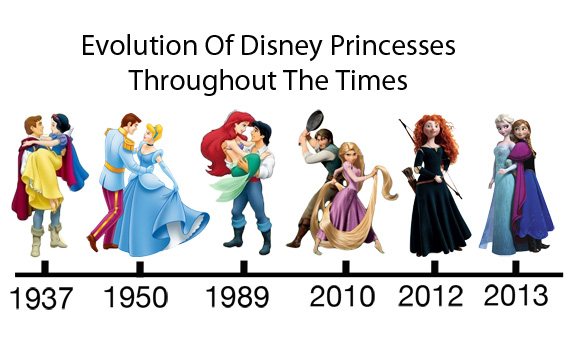
© Ashley Panther/Wordpress

© Ashley Panther/Wordpress
Since the introduction of the first Disney princess, they have undergone a remarkable transformation. From Snow White, who was completely domestic and dependent, to Merida, who is bold and unrestrained, Disney have made improvements in how they portray women. According to JiaYu Sun (2023), the evolution of Disney princesses can be divided into three generations.
The first generation of Disney princesses, the Classic Princesses, is characterised by passivity, obedience, and dependence on male rescue. Films such as Snow White and the Seven Dwarfs (1937), Cinderella (1950), and Sleeping Beauty (1959) portray female protagonists as sweet, caring, submissive, and good at domestic tasks. Their ultimate goal is to find love and achieve happiness through marriage. Their stories follow a structure in which they suffer under an evil stepmother or witch until a prince finally rescues them.
After a period of thirty years, Disney introduced a new type of princess: the Awaken Princesses. This generation includes Ariel from The Little Mermaid (1989), followed by Belle (Beauty and the Beast, 1991), Jasmine (Aladdin, 1992), Pocahontas (1995) and Mulan (1998). These princesses are distinguished by their stronger personalities, ambition and sense of adventure. A clear influence of the second wave of feminism can be seen during this period, in which women began to break away from traditional roles. Nevertheless, romance remains an important theme: almost all princesses from this generation are eventually paired with a man. This shows that the quest for independence is still influenced by romantic ideals.
The most recent generation of Disney princesses, the Independent Princesses, marks a radical departure from traditional princess narratives. Films like The Princess and the Frog (2009), Tangled (2010), Brave (2012), and Frozen (2013) introduce female protagonists who don’t need a prince to achieve their goals. These princesses are completely independent and self-aware. During this period, the emphasis is no longer on romance, but on self-realisation, family ties, and leadership. The films reflect the ideals of contemporary feminism: women can determine their own destiny without being dependent on male characters.